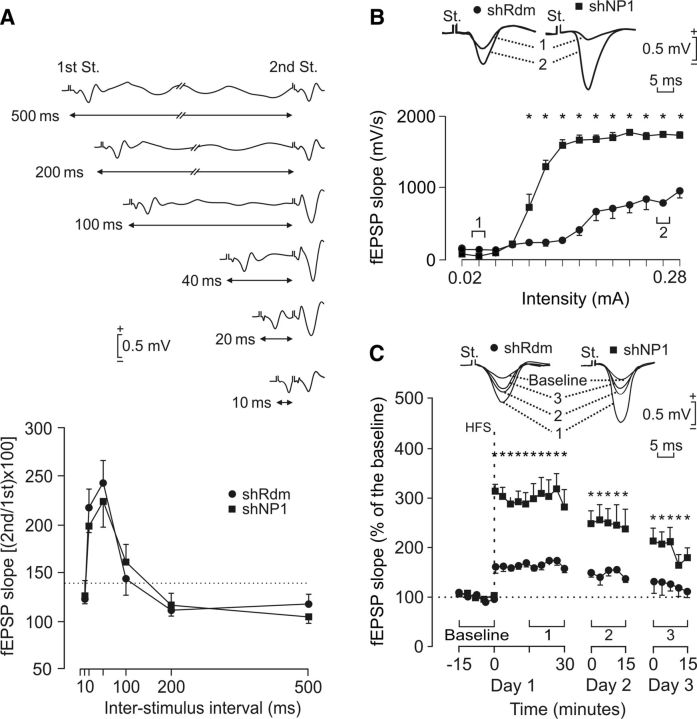Figure 9.
Knockdown of NP1 potentiates input/output curve and LTP and does not modify paired-pulse facilitation in the hippocampus of behaving mice. A, Comparison of paired-pulse facilitation between NP1 and control mice. The data shown are mean ± SEM slopes of the second fEPSP expressed as a percentage of the first for six interstimulus intervals. Both control shRdm (black circles) and shNP1 (black squares) mice presented similar paired-pulse facilitation at intervals of 20–500 ms using intensities indicated in (1) in B and C, respectively. Top, Some fEPSP paired traces collected from a representative NP1 knockdown mouse are shown. B, Input–output curves for the CA3-CA1 synapse. Single pulses were presented to Schaffer collaterals at increasing intensities while recording evoked fEPSPs at the CA1 area in control shRdm (black circles) and in shNP1 (black squares) mice. Representative fEPSPs collected from the two types of mouse are illustrated at the indicated times (1, 2). Values are mean ± SEM (n = 5). fEPSPs evoked by Schaffer collateral stimulation in NP1 knockdown animals were significantly larger (p < 0.001) than those collected from controls for intensities > 0.1 mA. C, Top, Illustrated examples of fEPSPs evoked by single pulses in selected control (black circles) and NP1 knockdown (black squares) animals before (baseline) and after (1–3) HFS of Schaffer collaterals. The bottom graphs illustrate the time course of LTP evoked in the CA1 area (fEPSP mean ± SEM) by single pulses following HFS for shRdm and shNP1 mice. HFS was presented after 15 min of baseline recordings, at the time marked by the dashed line. fEPSPs are given as a percentage of the baseline (100%) slope. Although the two groups presented a significant (p ≤ 0.01) increase (ANOVA, two-tailed) in fEPSP slope following HFS, values evoked in NP1 knockdown mice (9 animals) were significantly (p < 0.001) larger than those collected from controls (n = 9) for the whole set of records.

